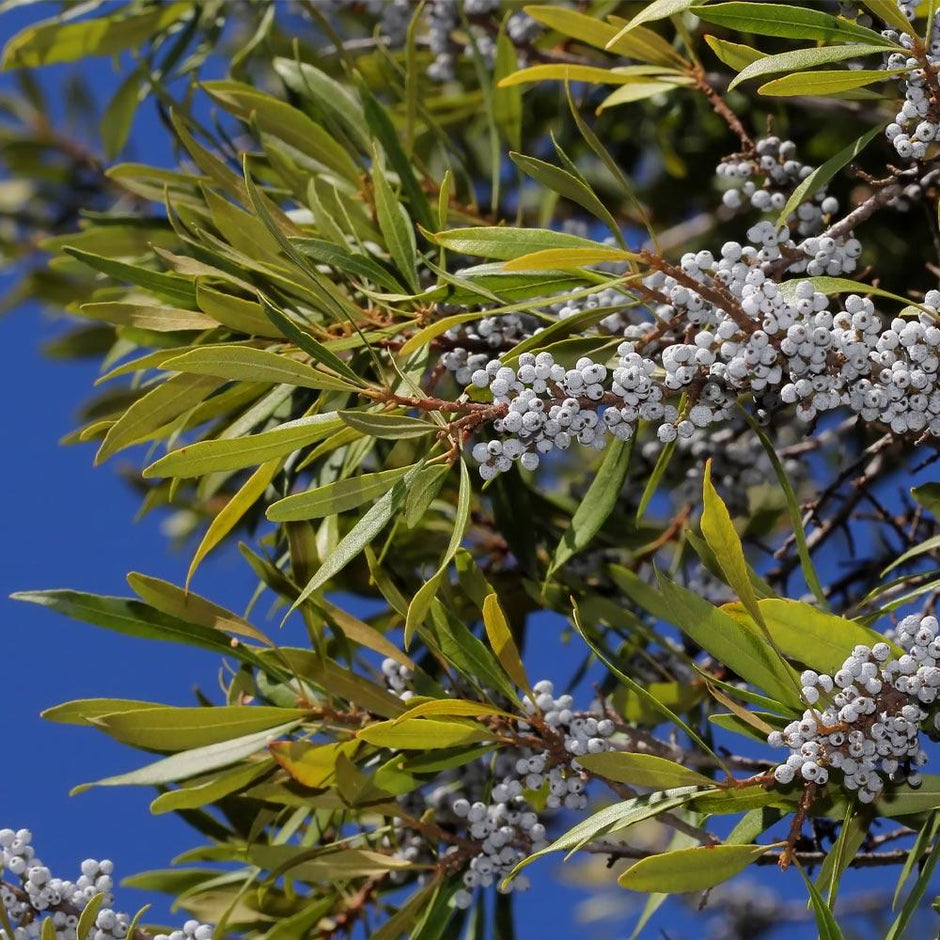

Wax Myrtle ( Myrica cerifera) is also known as Bayberry tree, because the waxy coating on the seeds is extracted and can be made into candles with the pleasant scent of the berries. It also encourages many wild birds that will come to feed on the berries or to nest in the safety of the dense branches. Being native also means that if you want to plant a wild area that will blend into the natural areas around your property, Wax Myrtle is an excellent choice. It is native to large parts of south-east North America, which means it well adapted to southern conditions. It is best grown in a warmer area as it does not like cold. This plant is resistant to deer so it can be grown in open areas or wild locations without being eaten. It is not affected by pests or diseases and is extremely hardy and trouble free. The glossy evergreen leaves of Wax Myrtle will resist drought and salt, making this plant the ideal choice for a beach cottage or any sandy, dry site. So you will get the rapid growth you need when the plants are young and lower maintenance once they mature – an ideal situation. It can add 5 feet in height in a single season but will slow down to 2 feet a year until it reaches 20 feet or so, when the growth will slow a little more as the plant matures. Once it has become established, Wax Myrtle will grow at an amazing rate.
#Wax myrtle shrubs free#
It is drought resistant, deer-resistant, free of pests and diseases, and will grow in almost any type of soil. The growth rate can be up to 5 feet in a year, so if you need a quick medium-sized hedge or screen, Wax Myrtle is a great choice. It will grow happily in sun or partial shade and very quickly fill-in and make a beautiful addition to your garden. It can also be pruned up into a small tree. It can be grown as a bushy shrub or clipped into an attractive hedge or screen. If you have a garden on the coast or in dry, sandy areas, then Wax Myrtle is the plant for you. This native plant is a great choice is you want a natural garden of native plants, but it also fits well into any garden and makes a great hedge on any property. It is unaffected by pests or diseases and it will not be eaten by deer, so it is a durable and easily-grown shrub. It is also very drought-resistant, so use it as a screen in areas where you cannot water.

You can plant Wax Myrtle in very poor soil and it will thrive. Make traditional candles from the berries.This is a great low-maintenance choice when looking for shrubs that grow well in milder areas of the country. If you leave the berries they will attract a variety of birds to your garden. Its attractive, glossy, fragrant evergreen leaves provide screening all year round and the berries, which are even more fragrant than the leaves, can be gathered and made into candles. It can grow up to 5 feet in a season and it can be kept low and bushy or pruned up into a tree around 20 feet tall. Wax Myrtle is a fast-growing shrub or small tree that is extremely hardy and resistant to drought, sandy soil, beach exposure, and salt-spray. We've gotta protect good ole' Mother Nature, after all. While we wish we could serve everyone, it's for the safety of native species and helps prevent the spread of invasive disease & pests. The short & sweet answer is: "United States Department of Agriculture Restrictions." Every state has their own unique USDA restrictions on which plants they allow to come into their state. You will receive email notifications along the way on the progress of your order, as well as tracking information to track your plants all the way to their new home! Why are some states excluded from shipping? Orders typically ship out within 2 business days. How does the delivery process work?Īll of our orders ship via FedEx Ground! Once your order is placed online, our magic elves get right to work picking, staging, boxing and shipping your trees. You'll find we carry young 1-gallons, up to more mature 7-gallons ranging anywhere from 6 inches to 6ft. While the industry-standard terminology is to call the sizes "Gallon Containers", that doesn't exactly translate to the traditional liquid "gallon" size we think of. Nursery containers come in a variety of different sizes, and old-school nursery slang has stuck. All tree, and nothin' but the tree! We measure from the top of the soil to the top of the tree the height of the container or the root system is never included in our measurements.


 0 kommentar(er)
0 kommentar(er)
